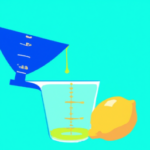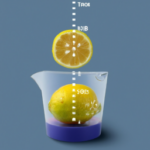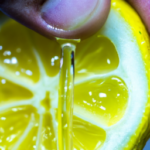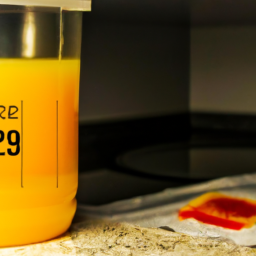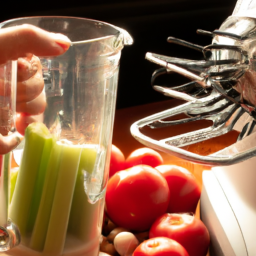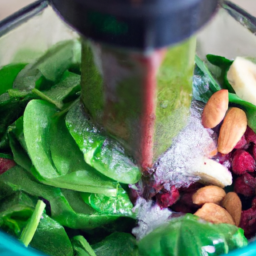As someone who loves to cook and bake, I often find myself needing lemon juice for different recipes. However, I always seem to get different amounts of juice each time I squeeze a lemon, which makes me wonder how much juice is actually in one lemon?
After doing some research and experimenting in my own kitchen, I have found that there are several factors that affect the amount of juice in a lemon, and understanding these factors can help you get the most out of your lemons.
One of the biggest factors that affects lemon yield is the variety of lemon you are using. Some varieties, such as Meyer lemons, are known for producing more juice than others. Additionally, the ripeness of the lemon, the temperature of the lemon, and the method used to juice the lemon can all impact the amount of juice you are able to extract.
In this article, we will dive deeper into these factors and provide tips for choosing the right lemons, juicing them efficiently, and getting the most juice out of each lemon.
Key Takeaways
- The amount of juice in 1 lemon can vary based on factors such as lemon variety, ripeness, and juicing method.
- To increase juice extraction efficiency, try rolling the lemon before juicing, using a lemon squeezer, or microwaving the lemon for a few seconds or piercing it with a fork/toothpick.
- Storing lemons at room temperature yields more juice than storing them in the fridge, but keeping them in the fridge can extend their shelf life up to 3 weeks and freezing them can preserve them for up to 6 months.
- Understanding lemon yield can help prevent wastage and determine the amount needed for a recipe. Lemons can also be used for cleaning solutions and natural air fresheners.
Factors that Affect the Amount of Juice in a Lemon
There’s no definitive answer to how much juice is in one lemon, as the amount can be influenced by various factors. For example, larger lemons tend to yield more juice than smaller ones, but this also depends on the ripeness of the fruit. The riper the lemon, the more juice it will contain.
Moreover, the storage conditions of the fruit can also affect the amount of juice it contains. Lemons that are stored at room temperature tend to yield more juice than those stored in the fridge, as the cold temperatures can cause the fruit to dry out and become less juicy.
Understanding lemon yield can be a bit tricky, as it can depend on several factors. However, by taking into account the lemon size, ripeness, and storage conditions, you can get a rough estimate of how much juice to expect from a single fruit.
Understanding Lemon Yield
Upon squeezing a lemon, one can extract a refreshing burst of tartness that awakens the taste buds. However, the amount of juice that can be extracted from a lemon can vary greatly depending on factors such as the type of lemon, its age, and its size.
To accurately measure lemon juice yield, it’s important to understand the process of lemon juice extraction. Lemon juice extraction can be done manually or with the help of a juicer. When manually extracting juice, it’s important to roll the lemon on a hard surface to break down the membranes inside the fruit before cutting it in half and squeezing. Using a juicer can increase efficiency, but it’s important to choose a juicer that’s compatible with the type of lemon being used.
Once the juice has been extracted, it can be measured by pouring it into a measuring cup or by weighing it on a kitchen scale. Understanding lemon yield can help in determining the amount of lemons needed for a recipe and can prevent wastage.
In choosing the right lemons, it’s important to look for lemons that are heavy for their size, as this indicates a higher juice content. Additionally, lemons that have smooth skin and are free from blemishes are likely to have a higher juice yield. By carefully selecting lemons and understanding the process of lemon juice extraction, one can ensure that they’re getting the most juice out of their fruit.
Choosing the Right Lemons
To choose the perfect lemon for your recipe, you’ll want to look for certain qualities that indicate a high yield of flavorful juice.
First, consider the ripeness of the lemon. A ripe lemon will have a slightly soft skin and give a bit when gently squeezed, indicating that it is full of juice. On the other hand, an unripe lemon will have a hard, firm skin and will yield less juice.
Secondly, freshness is key when selecting a lemon for juicing. Look for lemons that are firm and have a bright, vibrant color. Avoid lemons that are wrinkled or have soft spots, as they may be past their prime and will not produce as much juice.
Lastly, size does not necessarily indicate how much juice a lemon will yield, so don’t be swayed by larger lemons thinking they will have more juice.
When you have found the perfect lemon, it’s time to juice it. But how do you get the most juice out of your lemon? Let’s explore some techniques for juicing lemons.
How to Juice a Lemon
Get ready to roll your lemon on a hard surface to help break up the internal membranes and make it easier to extract the tangy citrus flavor. Once you’ve done that, cut the lemon in half and use a juicing technique that works for you.
Some people prefer to simply squeeze the lemon by hand, while others use a lemon squeezer for more efficient extraction. If you choose to squeeze the lemon by hand, make sure to apply firm pressure and twist the lemon as you squeeze. This will help to release the maximum amount of juice.
If you opt for a lemon squeezer, place the halved lemon in the squeezer and press down firmly to extract the juice. Whichever juicing technique you use, make sure to get as much juice out of the lemon as possible before moving on to the next step of your recipe.
To get the most juice out of your lemon, there are a few additional tips you can follow. One of them is to microwave the lemon for a few seconds before juicing it. This can help to break down the internal membranes and release more juice.
Another tip is to use a fork or toothpick to pierce the lemon before juicing, which can also help release more juice. With these techniques, you’ll be sure to get the most bang for your buck when it comes to juicing your lemons.
Getting the Most Juice Out of Your Lemon
When trying to extract every last drop of tangy citrus flavor from your lemon, there are a few tricks of the trade that can come in handy. One of the best ways to get the most juice out of your lemon is by using a lemon squeezer. This handy tool helps to crush the lemon and extract the juice without getting any seeds or pulp mixed in.
Another tip for juice extraction is to roll the lemon before cutting it. This helps to break down the membranes inside the lemon and release more juice.
Finally, make sure to warm the lemon up before squeezing it. This can be done by placing it in warm water for a few minutes or microwaving it for a few seconds. By following these tips, you can ensure that you get the most juice out of your lemon and enhance the flavors in your dishes.
Now, onto tips for storing lemons.
Tips for Storing Lemons
Properly storing your lemons can make all the difference in preserving their freshness and flavor for longer periods of time. Lemon preservation is important, especially if you have a surplus of lemons or want to extend their shelf life. One of the best ways to store lemons is to keep them in the refrigerator. Lemons can last up to three weeks when stored properly in the fridge.
Another way to store lemons is to freeze them. Freezing lemons is a great way to preserve them for longer periods of time, especially if you don’t plan on using them right away. Simply place whole lemons in a resealable plastic bag and freeze. When you’re ready to use them, take them out of the freezer and let them thaw at room temperature. Frozen lemons can last up to six months in the freezer. Once you’ve mastered the art of lemon preservation, you can start experimenting with creative lemon recipes like lemon meringue pie, lemon bars, or lemon chicken.
As for other uses for lemons, they have a wide range of benefits beyond cooking.
Other Uses for Lemons
There’s a plethora of ways to make use of lemons beyond just cooking. You can use them for cleaning solutions or add a slice to your water for a refreshing twist on hydration. Lemon-based cleaning solutions have become increasingly popular due to their natural disinfectant and deodorizing properties.
Using lemon in cooking and baking can also add a bright, fresh flavor to dishes, particularly in desserts like lemon bars or lemon meringue pie. In addition to these uses, lemons can also be used for their natural bleaching properties in laundry or as a natural air freshener when combined with essential oils.
The possibilities for using lemons are endless and their versatility makes them a staple in any household.
Next, let’s explore the different varieties of lemons and their unique characteristics.
Lemon Varieties
Did you know that you can explore the wide variety of lemons available and discover their unique characteristics? Lemon varieties differ in terms of their flavor, texture, and acidity levels. Some of the most popular lemon varieties include Eureka, Lisbon, Meyer, and Femminello.
Eureka lemon is the most commonly grown lemon variety in the United States and is known for its juicy, acidic, and sour flavor. Lisbon lemon is very similar to Eureka, but is typically larger and has a thicker skin. Meyer lemon, on the other hand, is a hybrid between a lemon and a mandarin orange. It is smaller than other lemon varieties and has a sweeter, less acidic flavor. Femminello lemon is a popular Italian lemon variety that is known for its bright yellow color and distinct aroma.
Lemon seasonality also varies depending on the variety. Some lemons are available year-round, while others are only in season during certain months. Understanding the different lemon varieties and their seasonality can help you choose the best lemon for your recipe or dish.
When it comes to lemon nutrition, lemons are a great source of vitamin C, fiber, and antioxidants. So, now that you know about the different lemon varieties and their unique characteristics, let’s dive into the nutritional benefits of lemons.
Lemon Nutrition
When it comes to nutrition, lemons are a true powerhouse. They’re a rich source of vitamin C, which helps boost immunity, improve skin health, and promote wound healing.
In addition, lemons contain other important nutrients like potassium, folate, and flavonoids. These nutrients have been linked to various health benefits such as lowering blood pressure and reducing inflammation.
Vitamin C Content
The Vitamin C content in a single lemon is enough to make your immune system jump for joy! In fact, a medium-sized lemon contains about 30-40mg of Vitamin C, which is approximately 50% of the recommended daily intake for adults.
Vitamin C is a powerful antioxidant that helps to protect cells from damage caused by free radicals and also plays a vital role in the production of collagen, which is essential for the health of our skin, bones, and muscles. Apart from its antioxidant properties, Vitamin C also has numerous benefits for our overall health.
Regular consumption of foods rich in Vitamin C, like lemons, can help to reduce the risk of chronic diseases, improve iron absorption, boost our immune system, and even promote healthy aging. Drinking lemon water, for instance, has been linked to various health benefits, including improved digestion, increased energy levels, and better skin health.
Moving on to other nutrients in lemons, they’re also a good source of fiber, potassium, and Vitamin B6, among others.
Other Nutrients in Lemons
Lemons also provide us with a good amount of fiber, potassium, and Vitamin B6, along with their impressive Vitamin C content. Including lemons in our diet can help regulate digestion, lower blood pressure, and strengthen our immune system.
In addition to their health benefits, lemons are also used in skincare to brighten and rejuvenate the skin. Incorporating lemon juice into a face mask or toner can help reduce dark spots and improve overall skin texture.
On the culinary side, lemons are a versatile ingredient that can be used in a variety of dishes, from savory to sweet. Lemon zest adds a bright flavor to pasta dishes, while lemon juice can be used to make a refreshing lemonade or a tangy salad dressing.
Moving on to the health benefits of lemons, this citrus fruit has been shown to have anti-inflammatory and anti-cancer properties. Consuming lemons may also lower the risk of heart disease and stroke.
With all of these benefits, it’s clear that lemons are a great addition to any diet.
Health Benefits of Lemons
Indulging in the zesty goodness of lemons is like giving your body a refreshing bath of vitality. Not only do lemons add an extra burst of flavor to your meals, but they also come packed with numerous health benefits. One of the most popular ways to reap the benefits of lemons is by drinking lemon water. This simple drink is a great way to start your day and is known to help with digestion, hydration, and even weight loss.
But lemon water is not just a trendy health drink. It has been used for centuries as a natural detoxifier. The citric acid in lemons helps to stimulate liver function, aiding in the removal of toxins from the body. Additionally, lemons are rich in vitamin C, which is known for its immune-boosting properties. So, the next time you’re looking for a way to give your body a natural cleanse, try incorporating lemon water into your daily routine. With its refreshing taste and numerous health benefits, it’s a win-win for your taste buds and your body.
| Benefit | Description | Evidence |
|---|---|---|
| Hydration | Lemon water is a great way to stay hydrated throughout the day. | A study found that drinking lemon water improved hydration levels in athletes compared to plain water. |
| Digestion | The citric acid in lemons can help to stimulate digestion and reduce bloating. | A review of studies found that lemon juice can improve digestion and reduce symptoms of indigestion. |
| Immune-Boosting | Lemons are rich in vitamin C, which is essential for a healthy immune system. | A study found that vitamin C can help to reduce the duration and severity of colds and flu. |
| Weight Loss | Drinking lemon water before meals may help to reduce appetite and promote weight loss. | A study found that participants who drank lemon water before meals had lower calorie intake and lost more weight than those who didn’t. |
Frequently Asked Questions
How many lemons should I use to make a cup of lemon juice?
To make a cup of lemon juice, I would need about 5-6 lemons depending on their size. If I don’t have enough lemons, I could use a lemon juice substitute or adjust the recipe accordingly. Lemon juice measurement is crucial for achieving the desired taste in recipes.
Can I use bottled lemon juice instead of freshly squeezed lemon juice?
Bottled lemon juice can be used instead of freshly squeezed, but the nutritional value may be lower. One interesting statistic is that 1 cup of bottled lemon juice contains the juice of 5-6 lemons.
How long does it take for a lemon to lose its juiciness after picking?
Factors affecting lemon juiciness include temperature, humidity, and age. To preserve lemon freshness, store them in a cool, dry place or refrigerate. It’s best to use freshly picked lemons within a week for optimal juiciness.
Can I freeze freshly squeezed lemon juice for later use?
Yes, freshly squeezed lemon juice can be frozen for later use using proper freezing techniques. To preserve freshness, pour the juice into a freezer-safe container leaving some space for expansion. Use within 6 months for best quality.
How can I tell if a lemon is ripe and juicy?
To determine lemon ripeness, look for a vibrant yellow color, heavy weight, and a slight give when squeezed. To preserve freshness, store in the fridge or freeze juice in ice cube trays.
Conclusion
In conclusion, the amount of juice in a lemon can vary based on several factors such as the size of the lemon, its ripeness, and the amount of pressure applied while juicing. However, by understanding lemon yield and choosing the right lemons, you can maximize the amount of juice you get out of each lemon.
When juicing a lemon, it’s important to use the proper technique and equipment to ensure you get the most juice possible. One metaphor that comes to mind when thinking about getting the most juice out of a lemon is squeezing every last drop out of life. Just as we want to make the most of our time on this earth, we should also strive to make the most of the resources we have, including our lemons.
By learning how to properly juice a lemon and store them correctly, we can extend their usefulness and enjoy the many benefits they offer. So go ahead, grab a lemon and start squeezing – you never know how much juice you might get until you try.
Ilana has been a vegan for over 10 years. She originally made the switch for health reasons, but soon found herself becoming more and more passionate about the ethical and environmental implications of a vegan lifestyle. Ilana is the author of The Graceful Kitchen, a blog all about veganism. She loves to cook up delicious and nutritious vegan meals, and share her recipes with others who are interested in leading a cruelty-free life. Ilana is also a strong advocate for using whole foods as the foundation of a healthy diet, and believes that going vegan is one of the best ways to achieve this.




